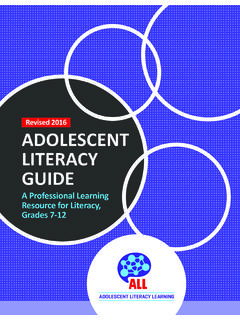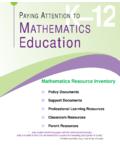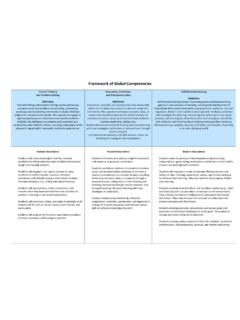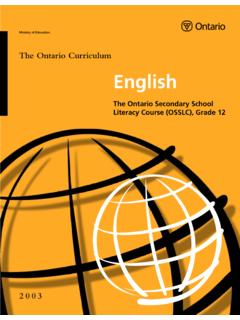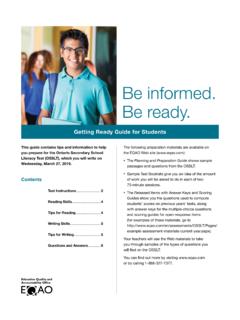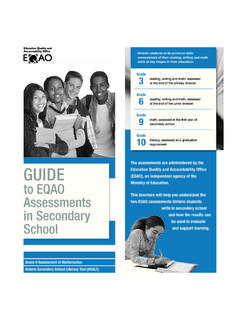Transcription of STEP User Guide Intial Assessment - EduGAINs Home
1 step . Initial Assessment Table of Contents step Initial Assessment Process 3. Welcoming New Families 4. Reception and Welcome Centres The Welcoming School Roles and Responsibilities Family Interview Student Profile Information Initial Assessment 9. Oral Assessment First Language Writing and Reading Samples Early literacy Tasks 13. Reading and Writing Assessment Tasks 17. Initial Placement on step Continua 18. Initial Mathematics Assessment 18. Recommendations for Support/Placement 20. Communicating 22. Designing Initial Reading and Writing Assessment Tasks 23. step Initial Assessment Process The initial Assessment is a snapshot in time that provides baseline information about an English language learner's (ELLs) level of English proficiency and literacy development. Steps to English Proficiency ( step ) Initial Assessment is intended for all teachers and administrators who welcome and assess English language learners who are newly arrived in their schools.
2 step supports the goal of the English Language Learners ESL and ELD. Programs and Services: Policies and Procedures for Ontario Elementary and Secondary Schools, Kindergarten to Grade 12, 2007 by: describing procedures for reception, orientation, placement, and programming for ELLs describing procedures for initial Assessment of ELLs suggesting the roles of administrators, teachers, students, and families suggesting procedures for gathering information related to the initial Assessment of ELLs Purpose of Initial Assessment The initial Assessment is an important first step in determining an ELL's language proficiency and literacy development in English. It is an opportunity to develop a profile that includes the student's educational, cultural, and personal background. The purpose of the initial Assessment is to determine: the student's language proficiency (oral, reading, and writing) and literacy development;. the student's mathematical skill level.
3 Appropriate programming supports;. appropriate placement. This flow chart illustrates the initial Assessment process. Welcoming New Families Initial registration, Welcome, Orientation, and Family interview Initial Assessment Student oral interview Picture response First language writing and reading sample Initial determination of subsequent Assessment tasks Early literacy Tasks Reading and Writing Assessment Tasks Initial Placement on step Continua Initial Mathematics Assessment Recommendations for Support/Placement Programs and support recommendations (elementary). Placement and support recommendations (secondary). Communicating Communicate with all stakeholders to facilitate collaboration and next steps step Initial Assessment June 20123. Welcoming New Families School boards will develop protocols to define procedures and practices for welcoming English language learners and their families and providing them with appropriate orientation to the Ontario school system, in the first language of the students and their families, whenever possible.
4 The protocol will include procedures for the admission of students in all grades, including Kindergarten regardless of level of English proficiency or prior schooling who arrive and need to begin school in Ontario at any time during the school year. English Language Learners ESL and ELD Programs and Services: Policies and Procedures for Ontario Elementary and Secondary Schools, Kindergarten to Grade 12, 2007. Reception and Welcoming Centres Some school boards have reception and welcoming centres where initial assessments are conducted and families receive information about the school board and community. In some boards the initial Assessment takes place in the school. The Welcoming School All schools should provide a reception and orientation program that ensures a warm welcome for ELLs and their families. Creating a welcoming and inclusive school environment for ELLs and their families is a whole-school activity requiring the commitment of the administrative team, teachers, support staff, and other leaders within the school community.
5 What a welcoming school looks like A welcoming school is an inviting place for students, staff, parents, and visitors. In a welcoming school: all staff are aware of and understand the process for receiving ELLs and their families information about community resources ( , libraries, community centres, adult ESL classes, places of worship, cultural organizations) is available in a variety of languages families are informed about the necessary documentation and process for school registration there is access to adult interpreters who can competently assist parents and help them fill out forms multilingual signs, in the languages of the community, are visible in the school Reception and orientation programs should include: a school reception team ( , the administrative team, office administrative assistant, ESL/ELD teacher, classroom teachers, guidance counsellor) as well as, an interpreter and/or settlement worker, as needed a designated place for the family and reception team to gather, meet, and share information orientation information about.
6 School calendar and routines content and use of student agenda school programs ESL and ELD programs and support school procedures in the event of absence, late arrival, or early leaving parental involvement ( , volunteering, Parent Council). community supports ( , settlement services, local adult ESL classes, and other community programs and resources). information about course selection (secondary). safe school policy student ambassadors 20124 step Initial Assessment June Welcoming New Families Roles and Responsibilities In creating a welcoming school environment, it is important that schools consider the needs of English language learners and their families. Supervisory officers, school administrators, classroom teachers, ESL/ELD teachers, initial assessors, parents, and students all have a role to play. Supervisory Officers To support the work of school administrators, supervisory officers should: ensure the board's vision for reception, orientation, and Assessment is shared and understood demonstrate a commitment to an inclusive, respectful, equitable environment for ELLs by allocating and monitoring financial and human resources develop a board culture that promotes shared knowledge and shared responsibility for student success by assisting principals in recognizing and articulating the learning their staff needs to support ELLs monitor the board's implementation of the ELL policy Principals and Vice Principals To successfully implement a reception and welcoming protocol, school administrators should.
7 Establish a school reception team establish procedures for reception, orientation, and registration establish a process for conducting and sharing step initial assessments and recommendations with school staff and with families establish a process for organizing, storing, and retrieving step initial Assessment data address the professional learning needs of teacher assessors facilitate opportunities for families to engage in and understand the Canadian school context facilitate access to community resources and/or settlement services School administrators can use the step initial Assessment to: support the implementation of board policies for programming/placement, monitoring, and tracking ELLs' language acquisition and literacy development provide data to focus discussion on students' needs facilitate discussion about teacher learning needs to support ELLs in language acquisition and literacy development establish the use of common language regarding second language acquisition facilitate decision making and focussed support for at-risk ELLs make informed decisions when planning programs and resources to support English language learners help families understand their child's level of English language proficiency and literacy development facilitate family engagement in pathways planning Initial Assessors The initial assessor may be a reception centre teacher, ESL/ELD teacher, classroom teacher, or a teacher assigned this responsibility.
8 An initial Assessment of an ELL provides information about the student's level of English proficiency and literacy development in the areas of oral, reading, and writing. This information is used by classroom teachers to help program for a student and to assist in determining the placement of a secondary student in appropriate courses. For secondary placement, students and parents should be informed that the initial placement is tentative. Schools should monitor over a period of time and revise the placement, if needed. The teacher who conducts this initial Assessment should: follow Reception Centre/school protocols for completing the Assessment and for communicating with the student's school and/or teachers review carefully information provided by the family to Guide their decision making begin a portfolio that contains step initial Assessment data and other information about the student make programming recommendations complete a tracking form step Initial Assessment June 20125.
9 Welcoming New Families ESL/ELD Teachers ESL/ELD teachers could be itinerant, or they could be assigned to a school. ESL/ELD teachers can use the initial Assessment to: facilitate discussion of the student's language proficiency, using a common language collaborate with colleagues to develop linguistically appropriate teaching strategies facilitate discussions with parents about their child's language acquisition and literacy development make recommendations for programming and/or placement select resources for ELLs Classroom/Subject Teachers Classroom/subject teachers can use information from the initial Assessment to: inform their instructional decisions for ELLs when they first arrive at a school Guide the selection of resources for ELLs in their classrooms facilitate discussions with parents about their child's language acquisition and literacy development create a classroom environment which reflects and celebrates the linguistic, personal, and cultural diversity of students Students Students can use information from the initial Assessment to.
10 Understand that language acquisition is an ongoing process understand their level of English language proficiency begin to learn about the supports available for ELLs in Ontario schools Parents Parents can use this information to: gain an understanding of their child's level of English language proficiency understand language acquisition as a long-term process begin to understand how their child can demonstrate learning begin to learn about the supports available for ELLs in Ontario schools 20126 step Initial Assessment June Welcoming New Families Family Interview The family interview is an integral part of the reception and orientation process. This interview is an opportunity for dialogue among the family, the student, and the assessor. It is an effective way to gather key information about the student and to provide essential information. Adequate time should be allocated so all parties can comfortably exchange necessary information and ask questions.
